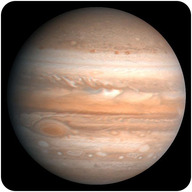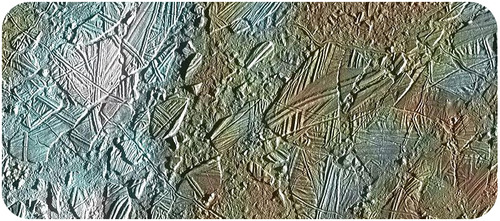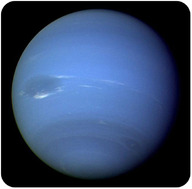Outer Planets
Lesson Objectives
- Describe key features of the outer planets and their moons.
- Compare the outer planets to each other and to Earth.
Vocabulary
- Galilean moons
- gas giants
- Great Red Spot
- outer planets
- planetary rings
Introduction
The four outer planets are farther from the Sun as well as farther from Earth. They are much more difficult to learn about since they are very different from our home planet.
The Outer Planets
The four planets farthest from the Sun are the outer planets. Figure below shows the relative sizes of the outer planets and the Sun. These planets are much larger than the inner planets and are made primarily of gases and liquids, so they are also called gas giants.
This image shows the four outer planets and the Sun, with sizes to scale. From left to right, the outer planets are Jupiter, Saturn, Uranus, and Neptune.
The gas giants are made up primarily of hydrogen and helium, the same elements that make up most of the Sun. Astronomers think that hydrogen and helium gases comprised much of the solar system when it first formed. Since the inner planets didn’t have enough mass to hold on to these light gases, their hydrogen and helium floated away into space. The Sun and the massive outer planets had enough gravity to keep hydrogen and helium from drifting away.
All of the outer planets have numerous moons. They all also have planetary rings, composed of dust and other small particles that encircle the planet in a thin plane.
Jupiter
Because Jupiter is so large, it reflects a lot of sunlight. Jupiter is extremely bright in the night sky; only the Moon and Venus are brighter (Figure below). This brightness is all the more impressive because Jupiter is quite far from the Earth — 5.20 AUs away. It takes Jupiter about 12 Earth years to orbit once around the Sun.
This image of Jupiter was taken by Voyager 2 in 1979. The colors were later enhanced to bring out more details.
Jupiter is named for the king of the gods in Roman mythology. The planet is enormous, the largest object in the solar system besides the Sun. Although Jupiter is over 1,300 times Earth’s volume, it has only 318 times the mass of Earth. Like the other gas giants, it is much less dense than Earth.
Check out NASA’s world book to learn more about Jupiter: http://www.nasa.gov/worldbook/jupiter_worldbook.html.
A Ball of Gas and Liquid
Astronauts trying to land a spaceship on the surface of Jupiter would find that there is no solid surface at all! Jupiter is made mostly of hydrogen, with some helium, and small amounts of other elements (Figure below).
Jupiter’s atmosphere is composed of hydrogen and helium. Deeper within the planet, pressure compresses the gases into a liquid. Some evidence suggests that Jupiter may have a small rocky core of heavier elements at its center.
A Stormy Atmosphere
The upper layer of Jupiter’s atmosphere contains clouds of ammonia (NH3) in bands of different colors. These bands rotate around the planet, but also swirl around in turbulent storms. The Great Red Spot (Figure below) is an enormous, oval-shaped storm found south of Jupiter’s equator. This storm is more than three times as wide as the entire Earth. Clouds in the storm rotate in a counterclockwise direction, making one complete turn every six days or so. The Great Red Spot has been on Jupiter for at least 300 years, since astronomers could first see the storm through telescopes. Do you think the Great Red Spot is a permanent feature on Jupiter? How could you know?
This image of Jupiter’s Great Red Spot (upper right of image) was taken by the Voyager 1 spacecraft. The white storm just below the Great Red Spot is about the same diameter as Earth.
Jupiter’s Moons and Rings
Jupiter has a very large number of moons — 63 have been discovered so far. Four are big enough and bright enough to be seen from Earth, using no more than a pair of binoculars. These moons — Io, Europa, Ganymede, and Callisto — were first discovered by Galileo in 1610, so they are sometimes referred to as the Galilean moons (Figure below). The Galilean moons are larger than the dwarf planets Pluto, Ceres, and Eris. Ganymede is not only the biggest moon in the solar system it is even larger than the planet Mercury!
This composite image shows the four Galilean moons and their sizes relative to the Great Red Spot. From top to bottom, the moons are Io, Europa, Ganymede, and Callisto. Jupiter’s Great Red Spot is in the background. Sizes are to scale.
Scientists are particularly interested in Europa because it may be a place to find extraterrestrial life. What features might make a satellite so far from the Sun a candidate for life? Although the surface of Europa is a smooth layer of ice, there is evidence that there is an ocean of liquid water underneath (Figure below). Europa also has a continual source of energy — it is heated as it is stretched and squashed by tidal forces from Jupiter. Numerous missions have been planned to explore Europa, including plans to drill through the ice and send a probe into the ocean. However, no such mission has yet been attempted.
An enhanced color image of a portion of Europa’s icy surface. The surface ice may have motions similar to plate tectonics on Earth.
In 1979, two spacecrafts — Voyager 1 and Voyager 2 — visited Jupiter and its moons. Photos from the Voyager missions showed that Jupiter has a ring system. This ring system is very faint, so it is difficult to observe from Earth.
Saturn
Saturn, shown in Figure below, is famous for its beautiful rings. Although all the gas giants have rings, only Saturn’s can be easily seen from Earth. In Roman mythology, Saturn was the father of Jupiter.
Saturn’s mass is about 95 times the mass of Earth, and its volume is 755 times Earth’s volume, making it the second largest planet in the solar system. Saturn is also the least dense planet in the solar system. It is less dense than water. What would happen if you had a large enough bathtub to put Saturn in? Saturn would float! Saturn orbits the Sun once about every 30 Earth years.
Like Jupiter, Saturn is made mostly of hydrogen and helium gases in the outer layers and liquids at greater depths. The upper atmosphere has clouds in bands of different colors. These rotate rapidly around the planet, but there seems to be less turbulence and fewer storms on Saturn than on Jupiter. One interesting phenomena that has been observed in the storms on Saturn is the presence of thunder and lightning (see video, below). The planet likely has a small rocky and metallic core.
Cassini scientists waited years for the right conditions to produce the first movie that shows lightning on another planet — Saturn.http://saturn.jpl.nasa.gov/video/videodetails/?videoID=210 Lots more videos from the Cassini mission are indexed here:http://saturn.jpl.nasa.gov/video/
Saturn’s Rings
In 1610 Galileo first observed Saturn’s rings with his telescope, but he thought they might be two large moons, one on either side of the planet. In 1659, the Dutch astronomer Christian Huygens realized that the features were rings (Figure below).
Saturn’s rings circle the planet’s equator and appear tilted because Saturn itself is tilted about 27 degrees. The rings do not touch the planet.
The Voyager 1 and 2 spacecraft in 1980 and 1981 sent back detailed pictures of Saturn, its rings, and some of its moons. Saturn’s rings are made of particles of water and ice, with some dust and rocks (Figure below). There are several gaps in the rings that scientists think have originated because (1) the material was cleared out by the gravitational pull within the rings or (2) by the gravitational forces of Saturn and of moons outside the rings.
The rings were likely formed by the breakup of one of Saturn’s moons or from material that never accreted into the planet when Saturn originally formed.
An animation of dark spokes in Saturn’s rings is seen here:http://en.wikipedia.org/wiki/File:Saturn_ring_spokes_PIA11144_300px_secs15.5to23_20080926.ogv. The spokes appear seasonally and their origin is as yet unknown.
Saturn’s Moons
Most of Saturn’s moons are very small and only seven are large enough for gravity to have made them spherical. Only Titan is larger than Earth’s Moon at about 1.5 times its size. Titan is even larger than the planet Mercury.
Scientists are interested in Titan because its atmosphere is similar to what Earth’s was like before life developed. Nitrogen is dominant and methane is the second most abundant gas. Titan may have a layer of liquid water and ammonia under a layer of surface ice. Lakes of liquid methane (CH4) and ethane (C2H6) are found on Titan’s surface. Although conditions are similar enough to those of early Earth for scientists to speculate that extremely primitive life may exist on Titan, the extreme cold and lack of carbon dioxide make it unlikely (Figure below).
Uranus
Uranus (YOOR-uh-nuhs) is named for the Greek god of the sky (Figure below). From Earth, Uranus is so faint that it was unnoticed by ancient observers. William Herschel first discovered the planet in 1781.
Although Uranus is very large, it is extremely far away, about 2.8 billion km (1.8 billion mi) from the Sun. Light from the Sun takes about 2 hours and 40 minutes to reach Uranus. Uranus orbits the Sun once about every 84 Earth years.
Uranus has a mass about 14 times the mass of Earth, but it is much less dense than Earth. Gravity at the surface of Uranus is weaker than on Earth’s surface so if you were at the top of the clouds on Uranus, you would weigh about 10% less than what you weigh on Earth.
An Icy Blue-Green Ball
Like Jupiter and Saturn, Uranus is composed mainly of hydrogen and helium, with an outer gas layer that gives way to liquid on the inside. Uranus has a higher percentage of icy materials, such as water, ammonia (NH3), and methane (CH4), than Jupiter and Saturn.
When sunlight reflects off Uranus, clouds of methane filter out red light, giving the planet a blue-green color. There are bands of clouds in the atmosphere of Uranus, but they are hard to see in normal light, so the planet looks like a plain blue ball.
The Sideways Planet
Most of the planets in the solar system rotate on their axes in the same direction that they move around the Sun. Uranus, though, is tilted on its side so its axis is almost parallel to its orbit. In other words, it rotates like a top that was turned so that it was spinning parallel to the floor. Scientists think that Uranus was probably knocked over by a collision with another planet-sized object billions of years ago.
Rings and Moons of Uranus
Uranus has a faint system of rings (Figure below). The rings circle the planet’s equator, but because Uranus is tilted on its side, the rings are almost perpendicular to the planet’s orbit.
This image from the Hubble Space Telescope shows the faint rings of Uranus. The planet is tilted on its side, so the rings are nearly vertical.
Uranus has 27 known moons and all but a few of them are named for characters from the plays of William Shakespeare. The five biggest moons of Uranus — Miranda, Ariel, Umbriel, Titania, and Oberon — are shown in Figure below.
These Voyager 2 photos have been resized to show the relative sizes of the five main moons of Uranus.
Neptune
Neptune, shown in Figure below, is the only major planet that can’t be seen from Earth without a telescope. Scientists predicted the existence of Neptune before it was discovered because Uranus did not always appear exactly where it should appear. They knew that the gravitational pull of another planet beyond Uranus must be affecting Uranus’ orbit.
Neptune was discovered in 1846, in the position that had been predicted, and it was named Neptune for the Roman god of the sea because of its bluish color.
This image of Neptune was taken by Voyager 2 in 1989. The Great Dark Spot seen on the left center in the picture has since disappeared, but a similar dark spot has appeared on another part of the planet.
In many respects, Neptune is similar to Uranus (Figure below). Neptune has slightly more mass than Uranus, but it is slightly smaller in size. Neptune is much farther from the Sun at nearly 4.5 billion km (2.8 billion mi). The planet’s slow orbit means that it takes 165 Earth years to go once around the Sun.
Neptune’s composition is that of a gas giant: (1) upper atmosphere, (2) atmosphere composed of hydrogen, helium and methane gas, (3) mantle of water, ammonia and methane ice, (4) core of rock and ice.
Extremes of Cold and Wind
Neptune’s blue color is mostly because of frozen methane (CH4). When Voyager 2 visited Neptune in 1986, there was a large dark-blue spot that scientists named the Great Dark Spot, south of the equator. When the Hubble Space Telescope took pictures of Neptune in 1994, the Great Dark Spot had disappeared but another dark spot had appeared north of the equator. Astronomers think that both of these spots represent gaps in the methane clouds on Neptune.
The changing appearance of Neptune is caused by its turbulent atmosphere. The winds on Neptune are stronger than on any other planet in the solar system, reaching speeds of 1,100 km/h (700 mi/h), close to the speed of sound. This extreme weather surprised astronomers, since the planet receives little energy from the Sun to power weather systems. Neptune is also one of the coldest places in the solar system. Temperatures at the top of the clouds are about -218oC (-360oF).
Neptune’s Rings and Moons
Neptune has faint rings of ice and dust that may change or disappear in fairly short time frames.
Neptune has 13 known moons. Triton, shown in Figure below, is the only one of them that has enough mass to be spherical in shape. Triton orbits in the direction opposite to the orbit of Neptune. Scientists think Triton did not form around Neptune, but instead was captured by Neptune’s gravity as it passed by.
Fly by Neptune’s moon Triton by watching this video: http://www.space.com/common/media/video/player.php?videoRef=mm32_SunDeath#playerTop
Lesson Summary
- The four outer planets are all gas giants made primarily of hydrogen and helium. They have thick gaseous outer layers and liquid interiors.
- The outer planets have numerous moons, as well as planetary rings.
- Jupiter, by far the largest planet in the solar system, has bands of different colored clouds, and a long-lasting storm called the Great Red Spot.
- Jupiter has more than 60 moons including the four largest, the Galilean moons.
- Europa has an ocean of liquid water under a layer of ice where life may have formed.
- Saturn is smaller than Jupiter but has a large system of beautiful rings.
- Titan’s atmosphere is similar to early Earth’s and the moon could harbor primitive life.
- Uranus and Neptune were discovered relatively recently since they are so far away.
- Uranus is tilted on its side, probably because of a past collision with a large object.
- Neptune is very cold and has strong winds. Its dark spots are storms in Neptune’s atmosphere.
Review Questions
1. Name the outer planets a) in order from the Sun outward, b) from largest to smallest by mass, and c) from largest to smallest by size.
2. Why are the outer planets called gas giants?
3. How do the Great Red Spot and Great Dark Spot differ?
4. Name the Galilean moons, and explain why they have that name.
5. Why might Europa be a likely place to find extraterrestrial life?
6. What causes gaps in Saturn’s rings?
7. Why are scientists interested in the atmosphere of Saturn’s moon Titan?
8. What liquid is found on the surface of Titan?
9. Why is Uranus blue-green in color?
10. What is the name of Neptune’s largest moon?
Further Reading / Supplemental Links
- Cool jobs! Planetary meteorologist: http://news.discovery.com/videos/discovery-news-2009-planetary-meteorologist.html
- About the Cassini Mission to Saturn: http://saturn.jpl.nasa.gov/
- NASA’s world book, Jupiter: http://www.nasa.gov/worldbook/jupiter_worldbook.html
- NASA’s planet selector: http://solarsystem.nasa.gov/planetselector.cfm
- Short videos of the planet Jupiter: http://www.youtube.com/watch?v=5iVw72sX3Bg;
- Video of Saturn: http://www.youtube.com/watch?v=iLXeUVCNoX8
- From the BBC Documentary, The Planets, Neptune: http://www.youtube.com/watch?v=29wfzotaBIg
Points to Consider
- The inner planets are small and rocky, while the outer planets are large and gaseous. Why might the planets have formed into these two groups?
- We have discussed the Sun, the planets, and the moons of the planets. What other objects can you think of that can be found in our solar system?

















